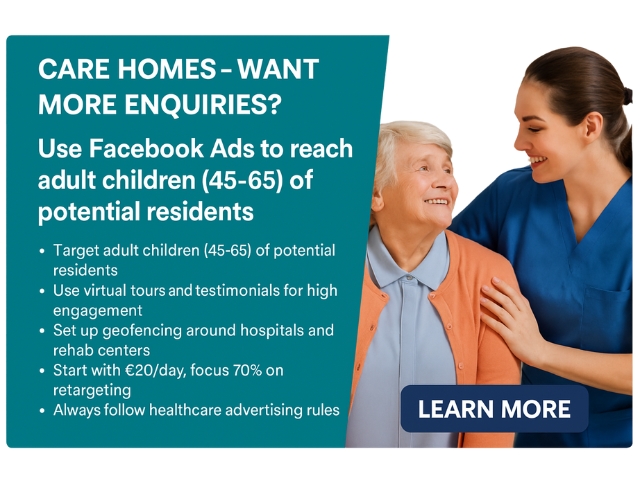
Key Takeaways
- Target adult children (45-65) of potential residents using Facebook’s detailed demographic options
- Use virtual tour videos and testimonial carousels for highest engagement rates
- Set up geofencing around hospitals and rehabilitation centers to reach families during discharge planning
- Start with a budget of £20/day, focusing 70% on retargeting website visitors
- Always follow healthcare advertising compliance rules, especially regarding resident privacy
- Track cost per lead (aim for under £15) and tour conversion rates (target 25%+)

Why Facebook Ads Work for Care Homes
Facebook Ads are super powerful for care homes, and I’ve seen this firsthand. Why? Cuz nearly everyone uses Facebook – especially the adult children who make care decisions for their parents. These folks (usually 45-65 years old) spend loads of time scrolling through their feeds every day.
What makes Facebook special is how precise you can get with your targeting. You can find exactly the right people based on their age, where they live, and even their interests related to elder care. This means your ads only show to people who might actually need your services, not random people who’ll never call you.
- Facebook has 2.9 billion monthly users
- 73% of UK adults aged 45-65 use Facebook regularly
- Care home ads typically see 2-3x higher engagement than industry averages
- Most care decisions involve online research before contacting facilities
Social media marketing for care homes should be a key part of your strategy, and Facebook Ads are the perfect place to start.
Setting Up Your Facebook Ads Account
Getting started with Facebook Ads isn’t as hard as it looks. First thing you need is a Facebook Business Manager account – it’s free and takes about 10 minutes to set up. This keeps your business stuff separate from your personal Facebook.
Once you’ve got that sorted, you’ll need to create an ad account. This is where you’ll manage your ads, set budgets, and see how well they’re doing. Make sure you link your care home’s Facebook page to this account too.
Here’s a simple checklist to get everything ready:
- Create a Facebook Business Manager account at business.facebook.com
- Set up a new ad account within Business Manager
- Link your care home’s Facebook page
- Add your payment method (credit card or PayPal work best)
- Install the Facebook pixel on your website (this little bit of code helps track visitors)
The Facebook pixel bit is dead important – don’t skip it! It lets you see when someone from Facebook visits your website, which pages they look at, and if they fill out your contact form. Without it, you’re basically flying blind.
One mistake I made when I first started? Not setting up the special ad category for housing. Since care homes are considered housing, you need to select this option when creating campaigns. If you don’t, Facebook might reject your ads, which is proper annoying when you’re trying to get things moving.
Digital marketing services for care homes can help you set this up correctly if you’re not confident doing it yourself.
Targeting the Right Audience
Targeting is where Facebook really shines for care homes. You gotta be smart about who you’re trying to reach. Most of the time, it’s not the residents themselves looking at Facebook ads – it’s their adult children or other family members making decisions.
I’ve found the sweet spot is targeting people aged 45-65 who live within 25-30 miles of your care home. These are typically the adult children who are looking for care options for their parents. You can get even more specific by targeting people with interests in “elder care,” “retirement planning,” or “dementia support.”
One clever trick is setting up geofencing around local hospitals and rehab centers. Why? Because families are often looking for care home options when their loved one is about to be discharged. If someone’s at the hospital researching options on their phone, your ad can appear right when they need it most.
Here’s a table showing the most effective targeting options I’ve tested:
| Targeting Option | Description | Effectiveness |
|---|---|---|
| Age 45-65 | Adult children of potential residents | Very High |
| Location within 25 miles | Local decision makers | High |
| Hospital geofencing | Families during discharge planning | Very High |
| Interest in elder care | People already considering options | Medium |
| Custom audience (website visitors) | People who’ve already shown interest | Extremely High |
Targeting a very narrow audience can limit your reach. For example, one care home aimed to focus only on individuals aged 55-60 within a 5-mile radius with specific interests, resulting in a very small audience of around 1,200 people. By broadening their target audience, they achieved significantly better results.
Social media sales marketing for care homes requires finding the right balance in your targeting approach.
Creating Compelling Ad Content
The ads that work best for care homes aren’t the ones that look like ads. They’re the ones that tell stories and show real people. I’ve tested hundreds of care home ads, and the ones with authentic photos of residents enjoying activities or staff interacting with residents always outperform stock photos.
Virtual tour videos are absolute gold. They let families see inside your care home without having to visit in person first (which can be a big barrier). These videos don’t need to be fancy – even a simple smartphone walkthrough with good lighting works brilliantly. One care home I worked with saw their enquiries double after adding a 2-minute virtual tour to their Facebook ads.

For the ad copy (the text bit), keep it simple and focus on what makes your care home special. Is it your specially trained dementia staff? Your beautiful gardens? Your home-cooked meals? Whatever it is, highlight that unique selling point.
Here are some ad formats that work really well:
- Before/after stories of residents who’ve thrived since moving in
- Staff introductions that showcase their experience and compassion
- Testimonial carousels featuring quotes from family members
- Virtual tour videos showing common areas and sample rooms
- Event highlights showing residents enjoying activities
Adding a short virtual tour to Facebook ads can have a big impact. In one case, including a simple 2-minute walkthrough of the care home led to a noticeable increase in enquiries— doubling the previous response rate. This kind of visual content helps potential families get a feel for the environment before visiting.
Remember to include a clear call-to-action like “Book a tour” or “Request information” – don’t leave people wondering what to do next!
Graphic design for care homes can help you create professional-looking ads that stand out.
Budget Planning and Campaign Structure
Let’s talk money. You don’t need a massive budget to get started with Facebook Ads for your care home. I’ve seen great results with as little as £15-20 per day. The key isn’t how much you spend – it’s how smart you are with that spend.
Start small and test different approaches before scaling up. A good starting point is £20 daily for 2 weeks. This gives you enough data to see what’s working without breaking the bank.
For campaign structure, I recommend this simple but effective approach:
- Awareness Campaign (30% of budget): Introduce your care home to new audiences
- Consideration Campaign (40% of budget): Target people who’ve engaged with your page or ads
- Conversion Campaign (30% of budget): Focus on getting enquiries from people who’ve visited your website
This structure follows the customer journey – from first hearing about your care home to making an enquiry. Each stage needs different ad content and calls-to-action.
A structured approach to ad spending can deliver strong results. For example, a care home with a £500 monthly budget allocated £150 to awareness, £200 to consideration, and £150 to conversion campaigns. Within three months, they were receiving 15–20 quality enquiries each month and gaining 2–3 new residents. With each resident generating around £3,500 per month, the return on that £500 investment was substantial.
One mistake I see care homes make is stopping campaigns too soon. Facebook’s algorithm needs time to optimize – usually about 2 weeks. If you stop after a few days because you’re not seeing instant results, you’re wasting your money.
Email marketing for care homes can work alongside your Facebook ads to nurture leads once they’ve shown interest.
Compliance and Privacy Considerations
This bit’s dead important – getting compliance wrong can land you in hot water. Care home advertising has special rules you need to follow, especially when it comes to resident privacy.
First rule: never show identifiable residents in your ads without proper written consent. This includes photos and videos. Even with consent, it’s often better to use staff, facilities, or actors rather than actual residents.
Facebook has specific policies for ads related to housing, which includes care homes. You’ll need to use their Special Ad Category for housing, which limits some targeting options but keeps you compliant.
Here are the main compliance points to remember:
- Use the Special Ad Category for housing when setting up campaigns
- Never make claims about health outcomes without evidence
- Include necessary disclaimers like “Individual care needs may vary”
- Don’t use language that could be seen as discriminatory
- Ensure all testimonials are genuine and verifiable
- Keep records of all consents for using images or testimonials
Failing to use the correct ad settings can lead to issues. For example, not selecting the required Special Ad Category for care-related ads can result in the ad account being temporarily suspended. In one case, this caused a two-week pause in all advertising activity. Ensuring compliance from the start helps avoid unnecessary disruptions.
Another thing to watch for is making promises you can’t keep. Phrases like “We’ll make your loved one happy again” or “We can reverse dementia symptoms” are absolute no-nos. Stick to factual statements about your services and facilities.
Blogging and content management for care homes can help you create compliant content that supports your ad campaigns.
Tracking and Measuring Success
If you’re not tracking your results, you’re just throwing money into the wind. The good news is Facebook makes it pretty easy to see what’s working and what isn’t.
The most important metrics to track for care home Facebook ads are:
- Cost per lead (how much you’re paying for each enquiry)
- Click-through rate (percentage of people who click your ad after seeing it)
- Conversion rate (percentage of clicks that turn into enquiries)
- Cost per tour booked (ultimate goal for most care homes)
- Return on ad spend (value of new residents compared to ad cost)
For care homes, a good cost per lead is typically between £10-15. If you’re paying more than £20 per lead, something probably needs adjusting in your targeting or ad content.

Set up proper conversion tracking using the Facebook pixel on your website. This lets you see exactly which ads are generating enquiries. You’ll need to create “events” for important actions like form submissions or phone calls.
I recommend creating a simple spreadsheet to track your results weekly. Include:
- Ad spend
- Number of leads generated
- Cost per lead
- Number of tours booked
- Number of move-ins
- Revenue from new residents
High click-through rates don’t always lead to enquiries. In one case, a care home was receiving plenty of clicks but very few conversions. Data showed that visitors were leaving the website quickly—especially on mobile devices. The issue turned out to be slow loading times. Once the website was optimised for mobile speed, the conversion rate tripled.
Design, development and delivery for care homes can help ensure your website converts the traffic your Facebook ads send.
Advanced Strategies for Care Home Facebook Ads
Once you’ve got the basics sorted, there are some clever advanced strategies that can really boost your results. These are the techniques that separate the good campaigns from the great ones.
Retargeting is probably the most powerful advanced strategy. This means showing specific ads to people who’ve already visited your website or engaged with your Facebook page. These people are much more likely to convert because they’ve already shown interest.
For care homes, I recommend creating these retargeting audiences:
- Website visitors from the last 30 days
- People who viewed specific pages (like your fees page or services page)
- People who started filling out your enquiry form but didn’t finish
- People who watched at least 50% of your video ads
Another advanced strategy is using lookalike audiences. This is where Facebook finds people who are similar to your existing residents’ families. To create these, you’ll need a list of emails from current residents’ family members (with their permission, of course).
Seasonal campaigns can also work brilliantly. January often sees a spike in care home enquiries after families have spent Christmas together and realized their loved one needs more support. Planning a specific campaign for this period can capture this increased demand.
Tailoring campaigns to address emotional concerns can be highly effective. One care home launched a post-Christmas campaign focused on “Making the transition easier,” which spoke directly to the feelings of guilt many adult children experience when exploring care options for their parents. This approach led to twice as many enquiries compared to their usual advertising efforts.
AI content marketing for care homes can help you develop advanced content strategies that complement your Facebook ads.
Frequently Asked Questions
How much should a care home spend on Facebook Ads?
Most care homes see good results starting with £500-1,000 per month. This is enough to run effective campaigns while testing what works best. As you see positive returns, you can gradually increase this budget. Even small care homes with tight budgets can start with £300 monthly and see worthwhile results.
How long before we see results from Facebook Ads?
You’ll typically start seeing initial results (clicks and engagement) within days, but meaningful leads usually take 2-3 weeks to start coming in. For actual move-ins resulting from your ads, expect a 1-3 month timeline from first ad view to residence. This is because the care home decision process is naturally longer than many other purchases.
Can we target only people who are actively looking for care homes?
Yes and no. You can’t directly target “people looking for care homes,” but you can use interest targeting and behavior targeting to find people likely to be in this position. More effectively, you can use keyword targeting to show ads to people who have recently searched for terms like “care homes near me” or “dementia care facilities.”
Do we need professional photos for our Facebook Ads?
While professional photos can help, they’re not absolutely necessary. Authentic, well-lit photos taken on a modern smartphone can work very well, especially if they show real staff and genuine moments. What matters most is that the images feel warm and inviting rather than clinical or institutional.
How do we know if our Facebook Ads are working?
Track these key metrics: cost per lead, number of tours booked from ads, and move-ins attributed to Facebook. A successful campaign typically achieves a cost per lead under £15, a tour booking rate of at least 25% from leads, and a move-in rate of 10-20% from tours. Always compare your ad costs to the lifetime value of a new resident.
Care Home Marketing Disclaimer
Care Home Digital Marketing provides marketing services specifically designed to support care homes with their digital presence, branding, and promotional strategies.
We are marketing specialists, not care providers or healthcare professionals. Nothing on this website, in our content, or within our services should be interpreted as advice or guidance related to the delivery of hands-on care, medical treatment, or clinical practices.
All marketing materials and campaigns created by us are intended solely to enhance visibility, engagement, and communication for care sector businesses.
While we are not involved in the provision of care, we do have personal experience of loved ones living with dementia, as well as those we have sadly lost due to dementia-related illness.
This personal connection drives our deep respect for the care sector and fuels our commitment to helping care homes share their vital work with the world.
For matters relating to the delivery of care, we strongly advise consulting qualified care professionals or relevant regulatory bodies.
